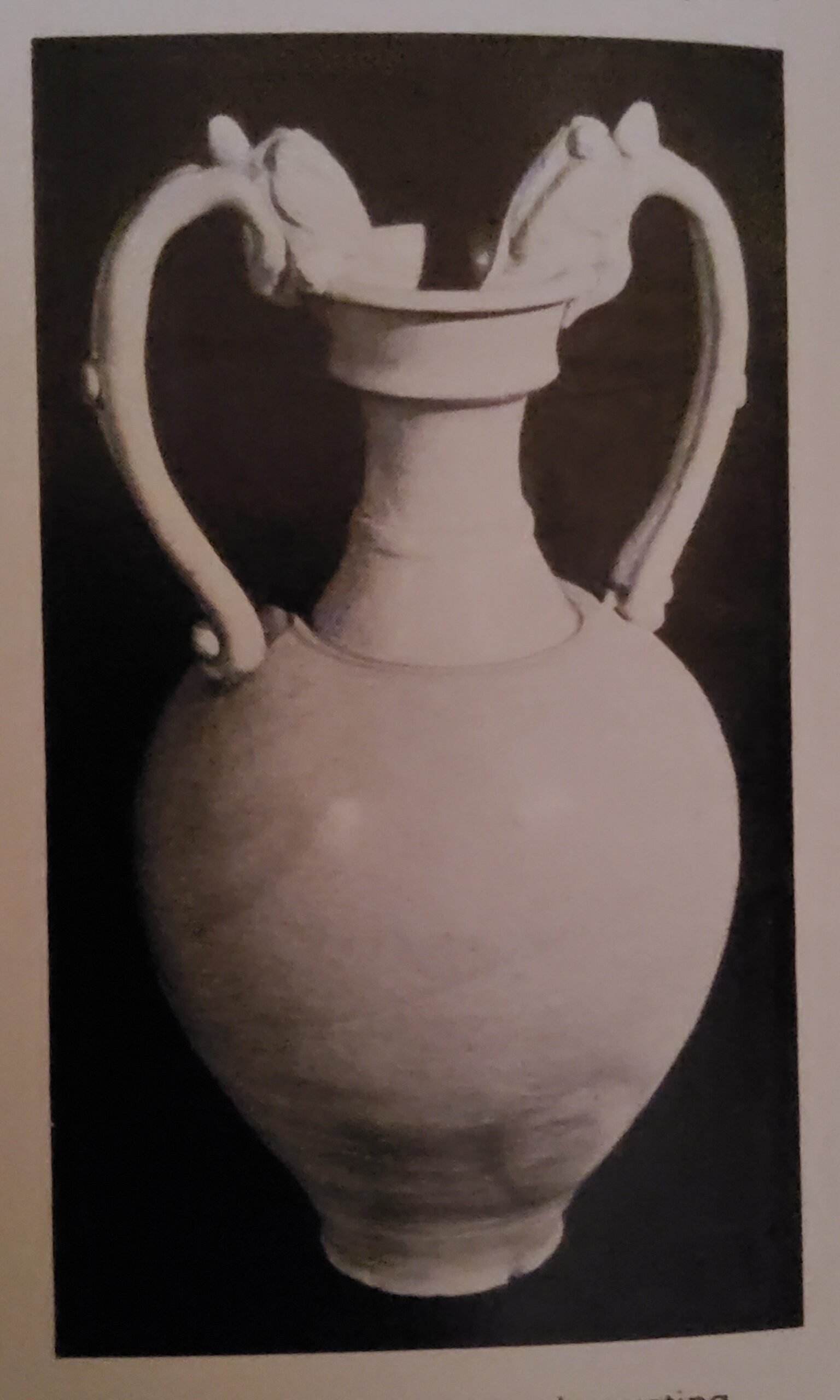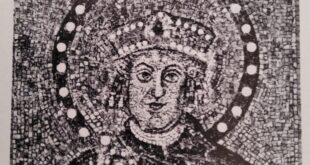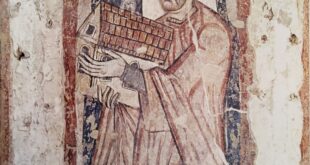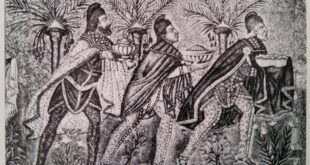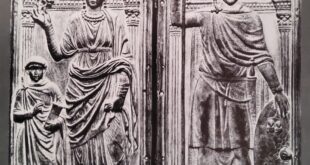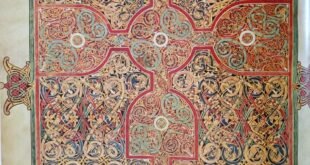T’ang Empire – first of the great Chinese dynasties – unifies the nation. The siege of Byzantium During the seventh and eighth centuries, while Europe was in the turmoil of the conflicting dynasties that had succeeded the first generations of barbarian invaders, events of immense importance were taking place on the southern shores of the Mediterranean. Within a hundred years, the armies of Islam had taken the legendary city of Samarkand in the East, while in the West they touched for a moment the banks of the Loire. The successor of the Prophet Mohammed was not to sit on the throne of Constantine until another eight centuries had elapsed, but throughout the seventh and early eighth centuries, the threat to Byzantium was a serious one. By 717 A.D., the Arab armies were actually at the gates of the imperial capital. Twice the siege was withstood; twice the Byzantine fleet proved its superiority and the armies of the new faith were driven back. Coin of the iconoclast Byzantine Emperor Leo Although they escaped military conquest, the Byzantines did succumb to the influence of the religious philosophy of their enemies. Within ten years of the first siege of Constantinople, the Emperor Leo III, issued the first “iconoclastic” decrees against the worship of images. For close to a century, the Church in the East, prohibited images of the saints – the descendants of local deities that Christianity had displaced – and permitted only the barest decoration of its places of worship. The puritanic zeal of Islam infected its rival; and the Emperor Leo, determined to withstand the attack of the infidel, did not hesitate to emulate his virtues. For, like Christianity, the faith of Islam claimed universality; like Christianity, it was exclusive. Islamic beliefs Islam, however, differed from Christianity in two important respects. …
Read More »Flight to Medina (622 A.D.)
The flight to Medina, was made by the prophet Mohammed, when he fled from his native Mecca, in hopes of finding a more receptive audience for his message. This event of 622, the Hegira, marks the beginning of the new Moslem religion and the beginning of a dynamic new civilization in the Middle East. Mohammed himself, proved to be both an inspired religious leader and an astute politician, creating a theocracy and presiding over it, as Allah’s Messenger. He also was a military leader. Mecca was soon brought into the Moslem orbit and at Mohammed’s death in 632 the entire Arabian Peninsula was his, but it remained for his successors, the caliphs, to impose Islamic rule over much of Asia and Africa and to bring a frightening challenge to Christian Europe. The mosque in Cairo, the earliest surviving example of a place of Moslem worship. The Moslem era begins in 622 A.D. the date of the Hegira, Mohammed’s emigration from his home town of Mecca to the neighbouring city of Medina. In fixing the date for the initiation of the Moslem era, Caliph Omar, successor to Mohammed’s first Caliph, Abu Bakr, is said to have hesitated between choosing the Hegira, the date of Mohammed’s birth, or the date he first accepted the vocation of prophet. When Omar chose the first alternative, he no doubt had good practical reasons: the date of the Hegira was better fixed in men’s minds than the less spectacular moment when Mohammed was finally convinced of his divine mission. Yet the Caliph may also have been quite conscious of the fact that it was the Hegira, even more than the first appearance of the angel Gabriel to Mohammed, that marked the historical epoch of the rise of Islam. In Mecca, Mohammed — a tradesman and previously …
Read More »Justinian Corpus (520-622 A.D.)
Justinian Corpus, the Juris Civilis, is the ancestor of all European legal systems. The sixth century – in the West, a period in which the seeds of a new type of monastic and Church-orinented culture and a fragmented political system were being planted. This century, was for the Eastern Roman Empire and its Persian rival, an age of great splendour. Despite the closing of Plato’s academy at Athens by Justinian in 529, the tradition of lay classical learning was never broken. Moreover, the Arab civilization emerging in Egypt, Syria and Persia continued and even developed that tradition. The case with which the Arabs overthrew Persia and conquered great tracts of territory from Rome, was largely the result of the fierce religous ardour of their new Moslem faith; but there were also weaknesses within these great empires. The Age of Justinian The Eastern Roman Empire was not unscathed by the turmoil of barbarian invasions, but whereas the Western Empire ceased to exist as a political entity, the East recovered. After a period during which the barbarians in the service of the imperial army had dictated events in Constantinople, there followed the reign of the Emperor Zeno. Although orthodox himself, he was willing to attempt a compromise with the powerful monophysite heresy, a heresy that denied the dual nature of Christ as man and God and claimed that he had only one nature — the divine. Zeno’s successor, Anastasius I, restored the failing finances of the Empire and laid the foundations of the greatness of the sixth century, but his monophysite tendencies were marked. His successor, the aging but well-entrenched chief of the imperial guard, Justin, permitted no half measures; his persecution of the monophysites was total; he launched the edict against pagans and heretics that so angered Theodoric, an Arian. If …
Read More »St. Benedict’s Rule 520 A.D.
St. Benedict’s monks tried to poison him, on one occasion it is said – and they often disregarded his instructions, but monasticism in the West, was created by St. Benedict. Before he founded Monte Cassino in 520, there were numerous other groups of monks in Europe, all with their own monastic rules, but Benedict’s Rule for his followers was the first to achieve general acceptance. It provided an ideal for monasticism that was at once disciplined and possible to achieve and maintain. With its emphasis on the individual monastery, Benedict’s Rule was ideally suited to a world degenerating into chaos ; and indeed, it was largely in Benedictine monasteries that classical learning survived during the Dark Ages. Perhaps more than any other single force, the Rule of St. Benedict gave adolescent Europe a message of fairness and a tradition of Christian behaviour. Some eighty-five miles southeast of Rome, the traveller to Naples, sees on the rocks of a towering hill, a large fortress-like building, with the cupola of a church in its midst. It is the abbey of Monte Cassino, reduced to dust by the Allied Air Forces in 1944 and now rebuilt in facsimile, to replace what was destroyed. In the early sixth century this was a remote region traversed only by herdsmen who were still pagan and on the summit of the hill, was a ruined temple of Apollo, together with a still earlier ruin of a fortress. About the year 520 the abbot Benedict, some forty years old, arrived at Monte Cassino with a small group of monks. He was attracted to the place, perhaps by the solitude of the hill and by the building stone available from the ruins. St. Benedict was born into a family in the higher level of society, possibly Roman in origin, …
Read More »Old Europe Crumbles (451 – 520 A.D.)
Old Europe crumbles as barbarian waves batter civilizations. Ironically, the victory on the Mauriac Plain sealed the fate both of victor and vanquished. After his death in 453, Attila’s empire broke up not only as a result of the feuds among his heirs, but also because of a successful rebellion among his German subjects. For the victorious Roman general, Actius, the outcome of the battle was still more directly catastrophic. He fell victim to a palace conspiracy of enemies who feared his immense prestige. The Emperor Valentinian III, is said to have boasted of the disposal of this powerful and popular rival to a favourite courtesan. Her laconic reply was: “‘You have cut off your right hand with your left.” With the sack of Rome in 455 by the armies of Gaiseric the Vandal, the weakness of the Western Empire was fully revealed. Thereafter, the influence of barbarians in the imperial court, which had been considerable, became supreme. From his victory over Vandal armies in 456 to his death in 472, the Suevian general Ricimer was arbiter of the fortunes of the West. Beyond the Alps, only the territories of Syagrius in northern France remained under Roman rule and these constituted, because of their isolation, a virtually independent kingdom, soon to be destroyed by Clovis. During the brief reign of Majorian (457 – 61), the best traditions of the Empire were revived by that competent and conscientious ruler, but his growing prestige was a threat to Ricimer, who had him deposed and murdered. For another fifteen years, the fiction of a Western Emperor was maintained, but in 476, the auspiciously named but pitiable figure of Romulus Augustulus was wiped out by the soldiers of Odoacer another successful German soldier, who like Ricimer, succeeded in wielding real power in the West. …
Read More »Attila, The Scourge of God (451 A.D.)
Attila, the “Scourge of God” was the legendary force that — curiously enough — helped to hold the tottering Roman Empire together for a few more years. Halfway through the fifth century, the Empire was defended by an array of feuding barbarian tribes enlisted as mercenaries. These tribes were united by a common fear of the Huns, who had left Central Asia to invade India, Persia, Central and Eastern Europe and were now threatening the West. Aetius, commander-in-chief of the Roman army, knew the Huns well and their leader, Attila, in particular — the Roman general had once been a hostage in the Huns’ camp. Aetius also knew that the real danger to the Empire came from within, from its disintegrating society. When Attila invaded Gaul, Aetius checked him at a battle fought southeast of Paris, but the Roman “victory” brought only a temporary halt to the inevitable fall of Rome. On the battlefield of the Campus Mauriacus — to the west of the old Gallo-Roman town of Troyes, some ninety miles southeast of Paris — two armies faced each other in the year 451. In retrospect, they might be seen as the forces of two contrasting worlds: Asia against Europe, the civilization of the plains against that of the towns, pagan barbarism against the Christian heritage of Greece and Rome, but this assessment would be superficial. Arrayed behind the Hun, Attila, was a horde of tribes more or less under his command: not only his own people but also Ruli, Heruli, Gepidae, Ostrogoths, Lombards and others. Opposed to him in defense of the Roman Empire was the last of the great Romans, the nobleman Aetius. Among his forces, there were hardly any Gallo-Romans, but a mixture of barbarian peoples whose loyalty was not to be relied on: Franks, Burgundians, …
Read More »Visigoths and Gaiseric (432 – 451 A.D.)
The Visigoths, led by Gaiseric, settle in North Africa and challenge Rome. Ireland before St. Patrick According to the most ancient traditions of Ireland, her history had been linked to that of the Mediterranean world long before the coming of St. Patrick and the religion of Rome. Even after St. Patrick, the history of the country was to remain, the preserve of an oral tradition handed down by a class of minstrels or bards. In western Europe, these minstrels were the latest heirs of an heroic Iron Age society, of which the earliest example known to us was the Greece described by Homer. At the time of Patrick’s mission, Ireland was ruled by Celtic kings and her society was by then entirely Celtic. Yet the picturesque and misleadingly precise lays of the bards not only traced the descent of every one of these kings back to the most remote past (genealogies which, after the acceptance of Christianity, were to stretch back to Adam), but also told of four conquerors, who had preceded the Celts. Their origins and their destinies must necessarily be classed as obscure, but we are told that when the original settlers of the island were defeated by the seafaring Fomors, many of them fled to Greece. The next race of invaders, the Tuatha De Danann (in whose name there might be a fossilized form of “Danai” — one of the names by which the ancient Greeks were known), made use of magical powers to assist them in their conquest. However, these arcane skills were not proof against the Milesians — according to the legend the last conquerors of the island and also a Celtic people. Early Celtic head from England, dating from the time of the Roman occupation. The Milesians, whose name also has an attractively Mediterranean …
Read More »Mission to Ireland (432 A.D.)
In the spring of 432, Laoghaire, ruler of a petty kingdom in northern Ireland, gathered his court near Tara to celebrate the annual rites of his pagan religion. The Christian missionary Patrick, appeared in the midst of the gathering, confounded the King’s magicians with a miracle of fire and — on Easter Sunday — converted Laoghaire. Patrick went on to strengthen the fledgling Christian Church in the Emerald Isle and to establish a religious tradition that was to endure for centuries. As Continental Europe slipped into the Dark Ages, following the collapse of the Roman Empire, it was the monks of Ireland who kept alive the flame of faith and who as missionaries — brought that faith back to the lands where it had been lost. According to the annals of Ireland, St. Patrick arrived there in 432 and died three decades later, in 461. His mission to Ireland had been prompted by a series of dreams or visions, which strengthened an earlier resolve to dedicate himself to God’s service. His great work, the Confessio (written about 450), is his spiritual autobiography, his account of his dependence upon God for his ability to carry out this resolve. We gather from Patrick’s own words that the journey of 432 was made with a set purpose, the evangelization of Ireland. He recognized to the full, his natural disabilities, such as teaching and writing in a tongue not his own, but outweighing all these, was his unshakable belief that God had dedicated him to be a bishop to the Irish. An inscribed stone at County Kerry in Ireland, one of several examples of monuments of pagan Druidic ritual which have been adapted with Christian symbols by early Christian worshipers for their own use. When St. Patrick went to Ireland he knew very well, what …
Read More »Arian Heresy and the Council of Nicaea (312-432 A. D.))
The Arian threat occured in the fourth century, which opened with the triumph of Christianity in the Roman Empire, closed with the beginning of the Dark Ages. Leaders of the barbarian tribes, massing outside the Empire’s frontiers, had already infiltrated their agents into the high places of imperial politics. The old order of Roman imperial administration, already severely weakened in the late third century and only partly restored by the reforms of Diocletian, was gradually disrupted during the years following Constantine’s death. Thus, the gulf between the East, where the imperial system continued and the West, where conditions of virtual anarchy came to prevail, can be clearly seen. The breakup of the West into a number of smaller units was already in prospect. The main subject of this passage will be events in Europe and the Eastern Roman Empire, but at the same time, things were happening outside Europe in some cases parallel to European history, in others, dramatically different from it. The World of the Orient In the Far East, the once-great empire of Han China had fallen apart in the early third century and China was long, to remain in a state of political turmoil. Then came the establishment of the Tsin dynasty in the year 265 and about this time, a new force was beginning to make itself felt in northern China. During the fourth and fifth centuries, meanwhile, the Tsin were to extend their power into the southeast and a new era, in Chinese social and cultural history, was inaugurated. Taoist stele; northern Wei period At first the Tsin power in the north had been severely curtailed by the incursion from beyond the frontiers of Hunnic tribes from central Asia. A number of warring barbarian dynasties were established in the north, but they were supplanted in …
Read More »In This Sign Shalt Thou Conquer (312 A.D.)
Constantine’s victory at the Milvian Bridge, ensures the spread of Christianity, throughout the Roman Empire. The Roman Empire, at the end of the third century A.D., was at the point of collapse. Struggles amongst rival emperors brought frequent civil wars, while barbarian hordes threatened the borders. Early in the new century, a soldier named Constantine proclaimed himself Emperor and immediately set out to make good his claim in a series of campaigns that took him, by the summer of 312, to the edge of Rome. Constantine had a momentous vision — a vision in which he was told, that he would conquer in the sign of the Cross, the symbol of the despised young Christian religion. The warrior’s subsequent victory at the Battle of the Milvian Bridge won for Christianity, an end to persecution and recognition as a legal religion. The third century of the Christian era was a grim, squalid age. For centuries the Roman Empire had maintained peace and fostered prosperity throughout the Mediterranean world, but now it was in decline. Stable central power had collapsed, as a succession of would-be warlords marched their predatory armies up and down the Empire, striving to seize power or to hold it against their rivals. Sometimes the legions actually put the Empire up for auction. At one and the same time, there might be three or four self-styled emperors. None of them lasted long. An allegorical figure on the pediment beneath the colossal head of Constantine in Rome, representing one of the provinces of the Empire. Meanwhile, the lot of the common man became ever more miserable and uncertain as cities were sacked, the countryside ravaged and wealth confiscated to pay the rapacious soldiery. Debasement of the currency and interruption of trade routes led to galloping inflation. The urbane, sophisticated culture …
Read More »